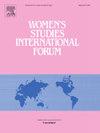超加工食品网络广告中的性别表现
IF 1.9
3区 社会学
Q2 WOMENS STUDIES
引用次数: 0
摘要
超加工食品的网络广告越来越多地出现在我们的日常生活中。品牌使用性别表征作为影响购买的工具,但表征缺乏多样性与人们的不同现实脱节。然而,文献尚未深入探讨这一主题。因此,本研究采用定性内容分析方法,考察了全球最受欢迎的14个超加工品牌广告中的视听信息是如何构建男性气质和女性气质的。我们观察到,男性和女性的表现是根据与霸权特征相关的不同概况组织起来的,在性取向、年龄、种族和体型方面几乎没有多样性。尽管如此,调查结果也显示了一些可供选择的话语,这可能表明品牌在吸引和保持消费者兴趣的策略上发生了变化。本文章由计算机程序翻译,如有差异,请以英文原文为准。
Gender representations in online food advertising of ultra-processed products
Online advertising of ultra-processed food products is increasingly present in our daily lives. Brands use gender representations as a tool to influence purchases, but lack of diversity in representations does not connect with people's different realities. Nonetheless, the literature has not yet explored this topic in depth. Therefore, this study uses qualitative content analysis methodology to examine how audiovisual messages construct masculinities and femininities in 14 advertisements of the most popular ultra-processed brands in the world. We have observed that male and female representations are organised according to different profiles related to hegemonic characteristics with little diversity in terms of sexual orientation, age, ethnicity and body types. Despite this fact, the results also show some alternative discourses that could indicate a change in the brands' strategies to attract and retain consumer interest.
求助全文
通过发布文献求助,成功后即可免费获取论文全文。
去求助
来源期刊

Womens Studies International Forum
WOMENS STUDIES-
CiteScore
2.50
自引率
7.10%
发文量
63
审稿时长
79 days
期刊介绍:
Women"s Studies International Forum (formerly Women"s Studies International Quarterly, established in 1978) is a bimonthly journal to aid the distribution and exchange of feminist research in the multidisciplinary, international area of women"s studies and in feminist research in other disciplines. The policy of the journal is to establish a feminist forum for discussion and debate. The journal seeks to critique and reconceptualize existing knowledge, to examine and re-evaluate the manner in which knowledge is produced and distributed, and to assess the implications this has for women"s lives.
 求助内容:
求助内容: 应助结果提醒方式:
应助结果提醒方式:


